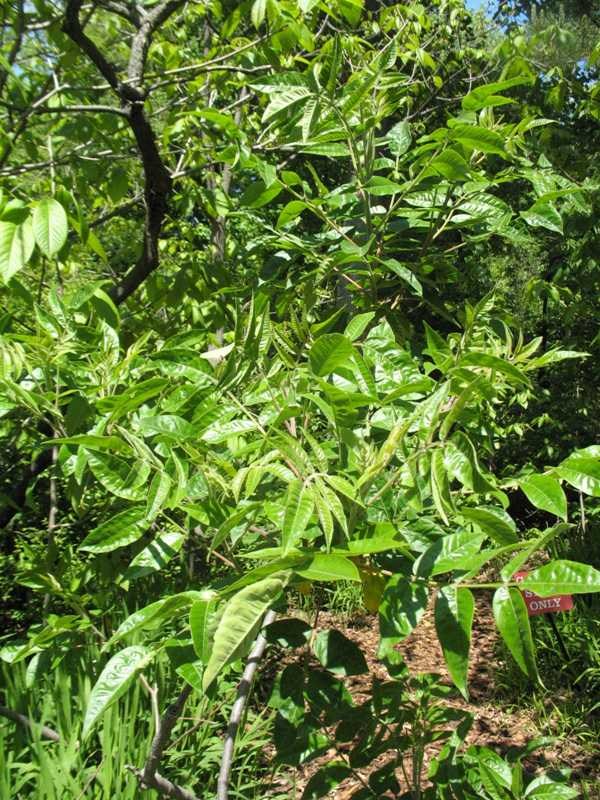Dwarf Sumac (Rhus copallinum var. latifolia)
Dwarf sumac
$41.00
$41.00
Rhus copallinum, commonly called dwarf sumac, flameleaf sumac, winged sumac and shining sumac, is a multi-stemmed, deciduous shrub that is native to eastern North America from New York to Alabama and Florida. It is a deciduous shrub or small tree which occurs in dryish soils on hillsides, open woods, glades, fields and along the margins of roadsides, railroad tracks and roads throughout most of the central and southern parts of the State. It is a large open shrub which typically grows to 10′ tall (rarely to 30′ as a tree) and spreads by root suckers to form large colonies in the wild. It is very similar to smooth sumac (Rhus glabra), except (a) leaflets are untoothed and (b) leaf midribs have leafy ridges or wings that give rise to another common name of winged sumac for this plant. Large, compound, odd-pinnate leaves (each with 9-21 untoothed, oblong-lanceolate, shiny dark green leaflets). Leaves turn flame red in autumn. Tiny, greenish-yellow flowers bloom in terminal pyramidal panicles in late spring to early summer, with separate male and female flowers usually occurring on separate plants (dioecious). Pollinated female flowers produce showy fruiting clusters (to 8″ long). Each cluster contains numerous hairy, berry-like drupes which ripen in autumn, gradually turning maroon-brown as they persist through much of the winter. Fruit is attractive to wildlife.
Var. latifolia is native to a larger area of eastern and central North America ranging from Maine to Nebraska south to Texas and Florida. Var. latifolia is primarily distinguished from species plants by its leaves (5-13 broad oblong to narrow ovate leaflets that are rounded at the base in comparison to species plants which typically have 9-21 narrower lance-shaped to linear-oblong leaflets that are narrowed to the base). Shrubs native to Missouri are var. latifolia. They are typically found in dryish soils on hillsides, open woods, glades, fields and along the margins of roadsides, railroad tracks and roads throughout most of the central and southern parts of the State (Steyermark). This shrub typically matures to 15-20′ tall and spreads by root suckers. It is densely branched when young, but opens up somewhat with age.
Genus name comes from the Greek name for one species, Rhus coriaria.
Specific epithet means gummy or resinous.

Easily grown in average, dry to medium moisture, well-drained soils in full sun to part shade. Tolerant of a wide range of soils except for those that are poorly drained. This shrub spreads over time by root suckers to form colonies.
| Hardiness zone | 4 - 9 |
| Sun light | Full sun to part shade |
| Water | Dry to medium |
| Maintenance | Low |
No serious insect or disease problems. Some susceptibility to verticillium wilt, leaf spots, rusts, powdery mildew, scale, aphids and mites.
This sumac is one of the most ornamental of the sumacs, featuring flower panicles in spring, shiny dark green summer foliage and excellent fall foliage color. It is an interesting selection for the landscape. It grows well in dry, informal, naturalized areas where it can be allowed to spread and form colonies. It is effective when massed on slopes for erosion control or in hard-to-cover areas with poorer soils. Naturalize in open woodland areas, wood margins or wild areas. Although it spreads by root suckers, it is not considered by most experts to be invasive and is sometimes suggested as a fall color substitute for Euonymous alatus which is invasive.
| Common name | Dwarf sumac |
| Botanical name | Rhus copallinum var. latifolia |
| Plant type | Deciduous shrub |
| Family | Anacardiaceae |
| Hardiness zone | 4 - 9 |
| Water | Dry to medium |
| Maintenance | Low |
| Flower color | Greenish-yellow |
| Flowering period | July - August |
| Height | 15 - 20 ft. |
| Width | 15 - 20 ft. |